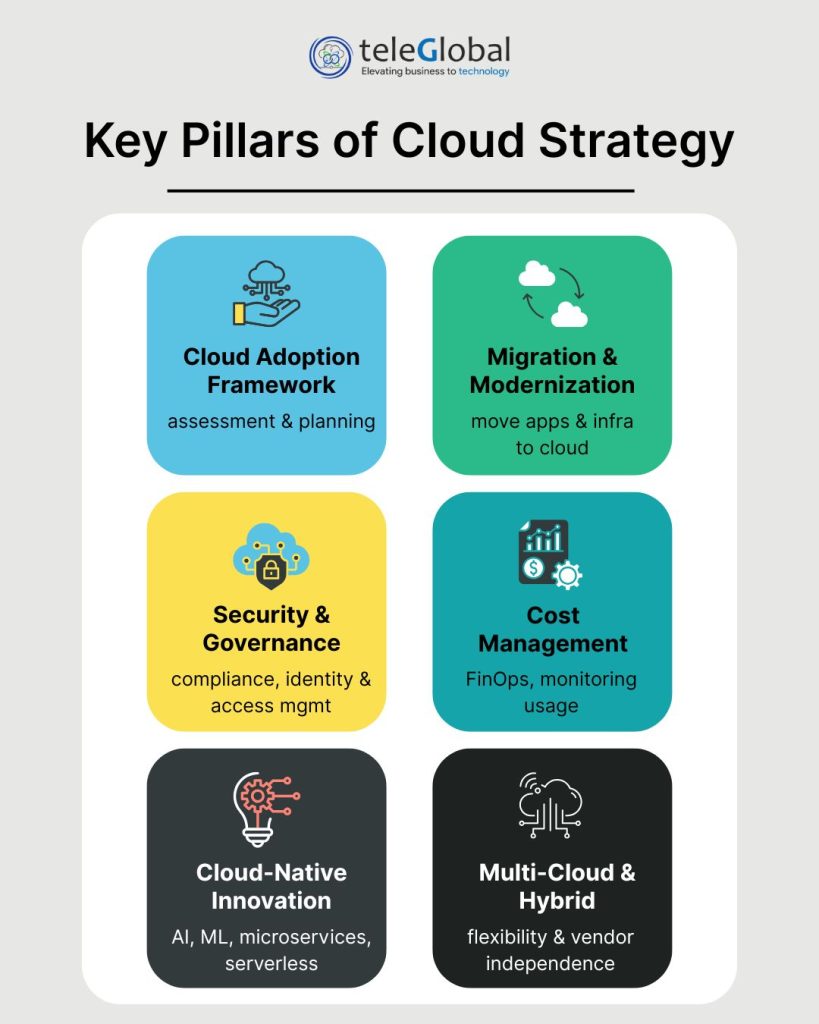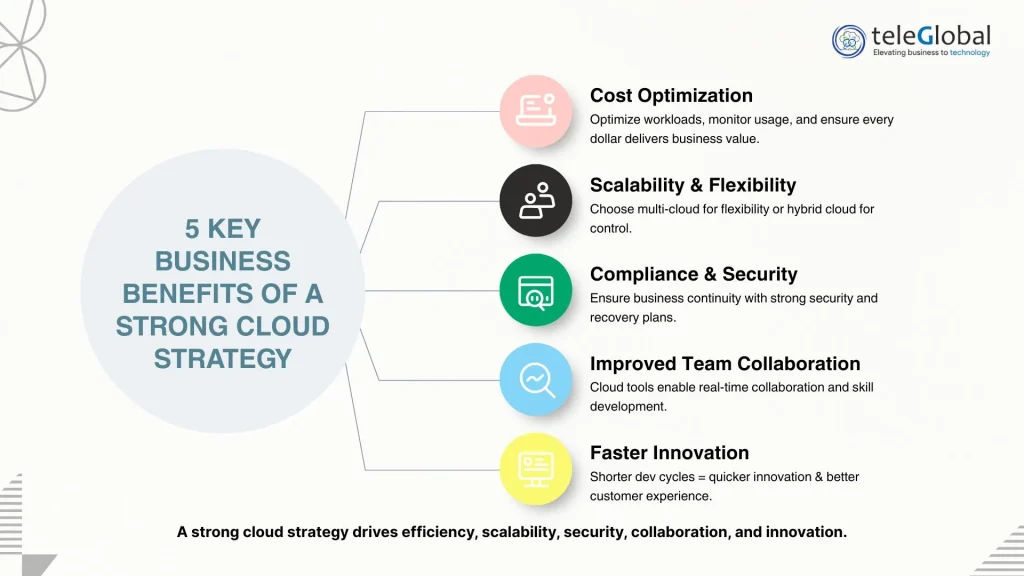
| Author: Ashish Kumar | Published: 03-Oct-2025 |
In 2025, businesses are running on speed, flexibility, and innovation. Without a cloud strategy, staying competitive becomes nearly impossible.
From small startups to global enterprises, companies rely on the cloud to lower costs, improve efficiency, and scale fast.
But moving to the cloud isn’t as simple as signing up for a service. It requires planning, foresight, and alignment with business goals. That’s where a step-by-step cloud strategy becomes essential.
This guide will help you understand what a cloud strategy is, why it matters, and how to build one that supports long-term success.
A cloud strategy is a structured plan that defines how a business uses the cloud to achieve its objectives. It’s not just about technology, it’s about aligning IT with the overall vision of the company.

At its core, a cloud adoption strategy answers questions like:
Think of it as a cloud roadmap. Without one, businesses risk overspending, facing compliance issues, or struggling with vendor lock-in. With a clear enterprise cloud strategy, organizations can make smarter choices about cloud service models like IaaS, PaaS, and SaaS, and manage them efficiently.
Developing a cloud strategy brings real business benefits. Let’s break down some of the most impactful ones:

One of the strongest cloud benefits is cost savings. But savings only happen with smart planning. A strong cloud implementation strategy helps manage expenses through cloud cost management and cloud performance tracking.
For example, moving legacy apps without optimization often leads to higher bills. A strong cloud roadmap ensures workloads are optimized for the cloud, avoiding wasted spend.
Markets shift fast. Companies must respond quickly to customer demands. With the right cloud deployment models, businesses can scale resources up or down instantly. Whether choosing a multi-cloud setup for flexibility or a hybrid cloud for control, a well-planned strategy ensures smooth scaling.
Security is a top concern for every business leader. Without a structured plan, cloud security and compliance risks rise. A proper enterprise cloud strategy includes strong policies for disaster recovery, business continuity, and compliance with legal requirements. This protects data while meeting industry regulations.
The cloud isn’t just about infrastructure, it changes how teams work. With managed cloud services and modern tools, employees collaborate in real time across locations. A strong cloud adoption strategy builds on this by ensuring proper staff training and upskilling, closing the skills gap that often slows transformation.
Today, companies don’t just migrate, they build cloud-native apps using serverless services, containerization, and Kubernetes. These modern technologies speed up development cycles, reduce downtime, and improve customer experiences. Businesses with a forward-looking enterprise cloud strategy stay ahead of competitors by embracing these innovations.
Every successful cloud strategy starts with careful planning. Jumping straight into migration without assessing readiness leads to wasted time and money.
Cloud planning begins by aligning IT goals with business objectives. Leaders should ask:
A strong enterprise cloud strategy begins with a business-focused assessment. This involves looking at the company’s current infrastructure, technical debt, compliance requirements, and financial limits.
The first step is to define outcomes. For some businesses, the goal is improved cloud cost management. For others, it might be better team collaboration or reducing downtime through disaster recovery and business continuity plans.
Readiness assessments include:
By completing this assessment, organizations avoid moving unfit workloads to the cloud and can prioritize legacy application migration more effectively.
Moving older systems is often one of the toughest challenges. Businesses must decide whether to:
For example, a company using an outdated CRM may find it cheaper and faster to switch to a SaaS-based CRM rather than rebuilding the old one in the cloud. A smart cloud implementation strategy weighs costs, risks, and timelines before making these choices.
Once planning is complete, the next step is creating a cloud roadmap. This roadmap acts as a step-by-step guide for how the business will adopt and scale the cloud.
A roadmap typically includes timelines, responsibilities, budgets, and milestones. Without one, businesses risk confusion, delays, and cost overruns.
One of the most critical decisions is selecting from cloud deployment models:
Choosing the right model depends on business priorities. For example, financial institutions often prefer private cloud for sensitive data, while e-commerce firms may choose public cloud for scaling traffic during peak shopping seasons.
The next layer in the cloud roadmap is deciding which cloud service models to use:
Most businesses end up using a mix of these models. A reliable enterprise cloud strategy makes sure the right balance is achieved, avoiding complexity and overspending.
Security and compliance are often the biggest worries for business leaders moving to the cloud. Without a strong cloud adoption strategy, organizations risk breaches, fines, and loss of trust.
A secure adoption plan should include three main areas:
Every industry faces its own compliance standards. Healthcare companies must meet HIPAA. Financial institutions deal with PCI DSS and GDPR. Failure to follow these rules can lead to legal penalties.
That’s why a good enterprise cloud strategy should map workloads to compliance needs. For example, sensitive customer data might stay in a private cloud, while less sensitive workloads run in a public cloud.
Legal teams should be involved early in cloud planning to avoid roadblocks later. By addressing legal requirements upfront, businesses protect themselves and maintain customer trust.
Relying too much on a single provider can create vendor lock-in. This makes it difficult and expensive to switch later.
A smart cloud roadmap reduces this risk by:
This way, businesses keep flexibility while still benefiting from managed cloud services.
Security doesn’t stop with compliance. It includes access controls, encryption, monitoring, and employee awareness.
Key actions include:
When leaders integrate these into their cloud adoption strategy, they build trust with both customers and stakeholders.
With planning, roadmap, and security in place, it’s time to execute. A strong cloud implementation strategy ensures smooth migration and long-term performance.
Traditional apps often don’t run efficiently in the cloud. That’s why modern technologies play a big role in transformation.
By adopting these, businesses can build cloud-native applications that deliver faster updates and better customer experiences.
Moving to the cloud isn’t automatically cheaper. Without planning, bills can rise quickly. A proper cloud cost management approach helps prevent this.
Steps include:
Once the cloud strategy is implemented, the focus shifts to governance and monitoring. Without strong oversight, costs rise, and security gaps emerge.
Cloud governance defines policies for cost, security, and compliance. A governance framework sets rules on who can deploy resources, how data is handled, and what security protocols are followed.
A good framework also enforces cloud operations standards. For example, all teams might need to follow the same approval process before deploying new workloads. This keeps systems consistent and secure.
Monitoring is critical to ensure the cloud delivers value. Businesses use cloud performance tracking to measure speed, uptime, and cost per unit of service.
Some metrics include:
This data helps with cost optimization and long-term growth planning.
Technology alone cannot drive transformation. People play the biggest role in making a cloud strategy successful.
Many businesses face a skills gap when adopting cloud. Teams may not have enough knowledge in Kubernetes, serverless services, or cloud-native design.
Investing in staff training and upskilling helps bridge this gap. Cloud providers often offer certification programs, which improve expertise and boost confidence.
Cloud adoption requires alignment across departments. IT, finance, operations, and compliance teams must work together.
A well-executed enterprise cloud strategy encourages team collaboration by using shared dashboards, performance reports, and governance policies. This makes decision-making faster and more transparent.
Even with a strong plan, businesses face hurdles during adoption. The most common include:
Leaders must anticipate these issues and address them proactively in the cloud roadmap.
Companies that thrive in the cloud follow a few best practices:
By treating the cloud as an ongoing journey, not a one-time project, businesses create lasting value.
In 2025, the cloud is a foundation for growth. A strong cloud strategy brings scalability, cost savings, and security while empowering teams to innovate faster.
By following a step-by-step cloud strategy from planning and roadmap design to adoption, implementation, and governance, businesses can utilise the full potential of the cloud.
The key is balance: adopt the right cloud deployment models, embrace modern services, and invest in people. With the right approach, your enterprise cloud strategy becomes a powerful driver of long-term success.
A cloud strategy is a plan for using the cloud to meet business goals. It helps reduce costs, improve scalability, and ensure cloud security.
The key steps include cloud planning, designing a cloud roadmap, building a secure cloud adoption strategy, implementing services, and setting up governance.
Each cloud deployment model serves different needs. Public cloud is cost-effective, private cloud is secure, hybrid cloud balances both, and multi-cloud reduces vendor lock-in.
Using cloud cost management tools, right-sizing workloads, and regular cloud monitoring helps achieve effective cost optimization.
Without staff training and upskilling, businesses face a skills gap. Trained teams ensure smooth cloud operations and faster innovation.
Vendor lock-in makes switching providers costly. Avoid it by using multi-cloud, containerization, and Kubernetes for flexibility.
Cloud-native apps built on serverless services and Kubernetes allow rapid scaling, faster updates, and better performance.
Work with legal teams, map workloads to compliance needs, and use a cloud governance framework to meet legal requirements.
 close
close

Hi there! At TeleGlobal, we turn your cloud vision into AI-accelerated reality. What challenge can we help you solve?
Powered by ![]() teleBot
teleBot